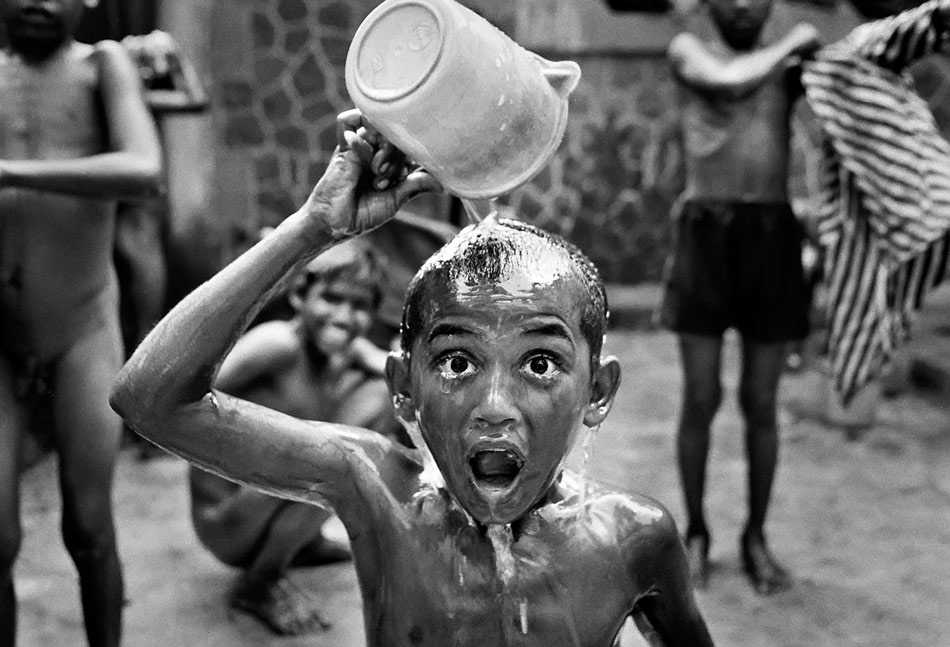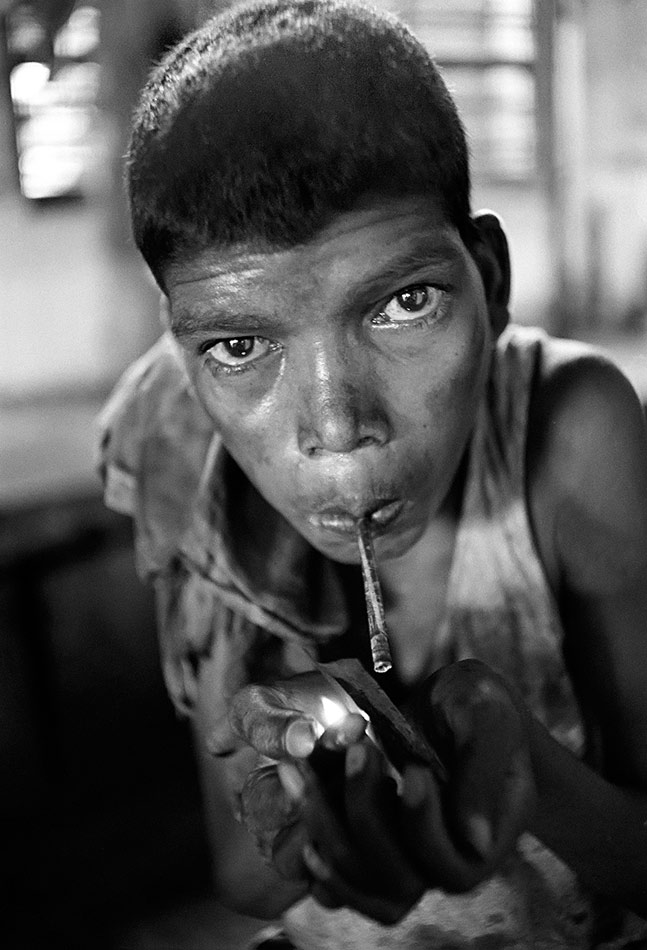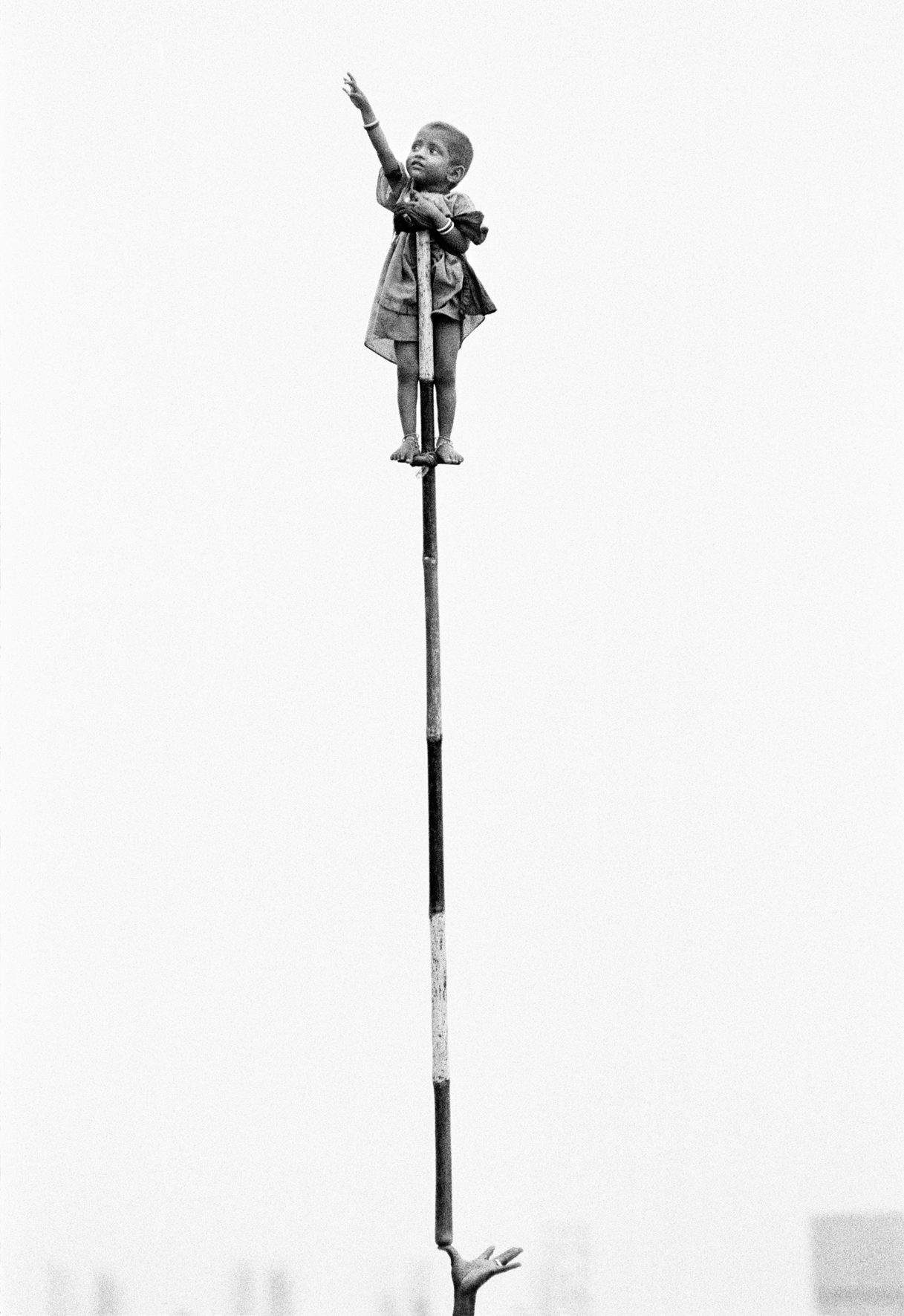In any society, where you come across poverty, you will also encounter the children growing up in it. Photographer Dario Mitidieri travelled to Bombay and documented the children who live on its streets, are confronted with paedophilia, drugs and incurable diseases on a daily basis. He gathered the hair-raising photographs and stories he heard into a book, which is called Children of Bombay and was first published all the way back in 1995. But I discovered it recently and cannot get enough of it, so I called him up for a chat.
Annons
VICE: Hey Dario, how’s your summer been? Did you get up to anything exciting?
Dario Mitidieri: I've just come back from holidays – I've been in Italy with my family.That's nice. Before you made Children of Bombay, you went to China and documented the 1989 Tiananmen Square massacre. Your photos were some of the first to be printed back in the West. What was that like?
When I went to China, I was already working as a freelance photographer for two of three years for newspapers like The Independent and The Telegraph. But still, it happened very suddenly, and as you can imagine the adrenalin was obviously running very high. It sunk in a few days later when I was watching it on TV and seeing it in the papers. A few months later, I managed to win the British Press Photographer of The Year award.
Dario Mitidieri: I've just come back from holidays – I've been in Italy with my family.That's nice. Before you made Children of Bombay, you went to China and documented the 1989 Tiananmen Square massacre. Your photos were some of the first to be printed back in the West. What was that like?
When I went to China, I was already working as a freelance photographer for two of three years for newspapers like The Independent and The Telegraph. But still, it happened very suddenly, and as you can imagine the adrenalin was obviously running very high. It sunk in a few days later when I was watching it on TV and seeing it in the papers. A few months later, I managed to win the British Press Photographer of The Year award.

Did that make Children of Bombay any easier to make?
Well yes, that’s the thing about the Bombay project. Photographs of street children aren’t exactly the most commercially valuable thing. So I had to win a few awards in order to realise it. I won the Eugene Smith so that I could get to Bombay. Then, various publishers loved the work, but they were all like "No, thanks." I struggled. In order to get it published, I had to win another award. I did that, and in the end, the book was published in six different languages across Europe.
Well yes, that’s the thing about the Bombay project. Photographs of street children aren’t exactly the most commercially valuable thing. So I had to win a few awards in order to realise it. I won the Eugene Smith so that I could get to Bombay. Then, various publishers loved the work, but they were all like "No, thanks." I struggled. In order to get it published, I had to win another award. I did that, and in the end, the book was published in six different languages across Europe.

That’s crazy, I didn’t realise that you had to go to so much effort to get a book published.
Yeah, I felt like there was so much resistance. It just proved that it doesn’t matter how strong the message is, unless you keep pushing it and winning awards, your work won’t get anywhere.
Yeah, I felt like there was so much resistance. It just proved that it doesn’t matter how strong the message is, unless you keep pushing it and winning awards, your work won’t get anywhere.
Annons
What actually inspired you to produce Street Children Of Bombay?
It all happened by coincidence. I was out in Bombay working on a story about AIDS in India. I was commissioned by Der Spiegel magazine to spend a few days taking photographs for an article about street children around the world. That's when I realised how big the story was. There was no way I could turn away as I was only scratching at the surface, so I applied for funding from the Eugene Smith grant. The idea was to go back and spend an entire year there.There’s one image that sets me back the most; that of a child using drugs. Are there any that still effect you more than the rest?
There are a couple, yes – one of two kids smoking heroin and one of a girl standing on a pole. It’s what made the project, it’s the image that stuck in everybody’s mind.
It all happened by coincidence. I was out in Bombay working on a story about AIDS in India. I was commissioned by Der Spiegel magazine to spend a few days taking photographs for an article about street children around the world. That's when I realised how big the story was. There was no way I could turn away as I was only scratching at the surface, so I applied for funding from the Eugene Smith grant. The idea was to go back and spend an entire year there.There’s one image that sets me back the most; that of a child using drugs. Are there any that still effect you more than the rest?
There are a couple, yes – one of two kids smoking heroin and one of a girl standing on a pole. It’s what made the project, it’s the image that stuck in everybody’s mind.

When shooting your subjects, did you get to know them quite well?
Oh yes, of course, I was with them day and night. They used to call me Uncle. We did a documentary about trying to find that girl on the pole. Which we did, and it got emotional at times. I even found others, which were five, six, seven years old when I took the photos and now they are adults. It was like yesterday. They remember everything and everything about me.
Oh yes, of course, I was with them day and night. They used to call me Uncle. We did a documentary about trying to find that girl on the pole. Which we did, and it got emotional at times. I even found others, which were five, six, seven years old when I took the photos and now they are adults. It was like yesterday. They remember everything and everything about me.

Do you think your work had any impact on their lives?
Not really. It did impact them indirectly, in that the photographs got used extensively by the NGOs dealing with children living in the streets. They use them to raise money. In Bombay we were dealing with paedophilia on the beach. There are a couple of photographs in the book. I kept quiet about that while the project was running, but soon as I’d finished with the project we contacted the police and they cleared the beach of paedophiles. So, this proves that photography can have meaning beyond the image.
Not really. It did impact them indirectly, in that the photographs got used extensively by the NGOs dealing with children living in the streets. They use them to raise money. In Bombay we were dealing with paedophilia on the beach. There are a couple of photographs in the book. I kept quiet about that while the project was running, but soon as I’d finished with the project we contacted the police and they cleared the beach of paedophiles. So, this proves that photography can have meaning beyond the image.
Annons
Have you ever considered running a similar project in another place?
I tried to contact people, but it’s hard to get people really interested. Unless you win awards, as I said. Unless you speak to the right people or go through the right channels, it's very difficult.I’ve also seen the photos from the tsunami in Indonesia. What was it like to be shooting in the aftermath of one of nature’s biggest disasters?
It was actually quite extraordinary. I lost everything, my clothes, medicines and food. It was a struggle. I didn’t have anything. Very slowly, I managed to find stuff like toothpaste, the essentials. I ended up sleeping on the floor. When I was supposed to go back to London, that's when they found my bag!Was there anything from that trip that you would never forget?
The one thing I would never forget about that trip is the… scale of it. There was nothing left. I remember going along the coast in a helicopter and you could see that everything had been wiped out by the waves, flattened, it was extraordinary.Was it more than you expected?
Much more. It was even unrealistic to a journalist. Anyone that worked there during that time, will tell you the same thing: No words or photographs can really explain how it was. There were massive ships, for example in the middle of fields, hills; things in places where they really don’t belong.You can see more of Dario's work here. And you can follow Jake on Twitter by clicking here @Jake_Photo.
I tried to contact people, but it’s hard to get people really interested. Unless you win awards, as I said. Unless you speak to the right people or go through the right channels, it's very difficult.I’ve also seen the photos from the tsunami in Indonesia. What was it like to be shooting in the aftermath of one of nature’s biggest disasters?
It was actually quite extraordinary. I lost everything, my clothes, medicines and food. It was a struggle. I didn’t have anything. Very slowly, I managed to find stuff like toothpaste, the essentials. I ended up sleeping on the floor. When I was supposed to go back to London, that's when they found my bag!Was there anything from that trip that you would never forget?
The one thing I would never forget about that trip is the… scale of it. There was nothing left. I remember going along the coast in a helicopter and you could see that everything had been wiped out by the waves, flattened, it was extraordinary.Was it more than you expected?
Much more. It was even unrealistic to a journalist. Anyone that worked there during that time, will tell you the same thing: No words or photographs can really explain how it was. There were massive ships, for example in the middle of fields, hills; things in places where they really don’t belong.You can see more of Dario's work here. And you can follow Jake on Twitter by clicking here @Jake_Photo.
Annons
More photography based on the lives of children around the world:Photographing the Children of Russia's Nouveau RicheChildren of Bucharest's SewerTaking Pictures of Dead Children's Bedrooms